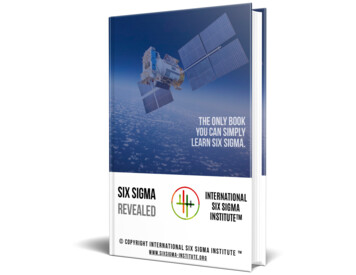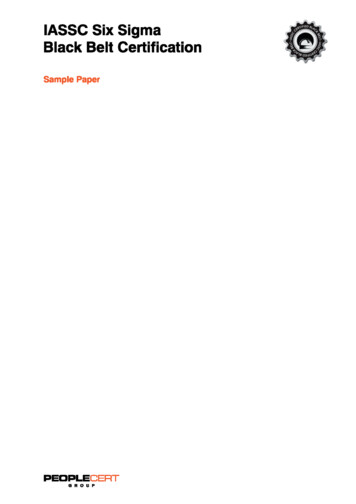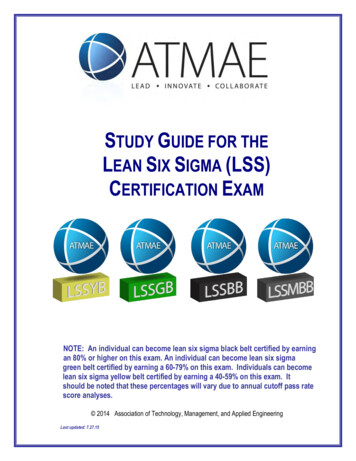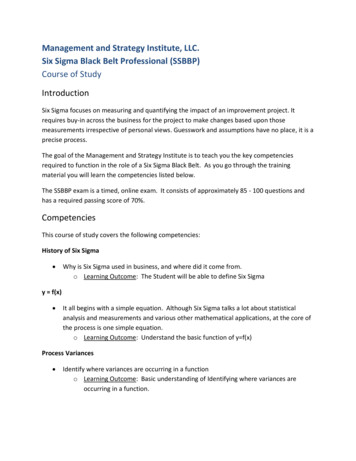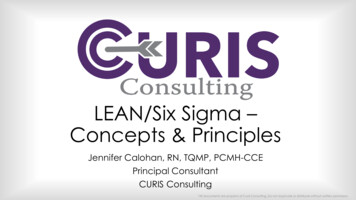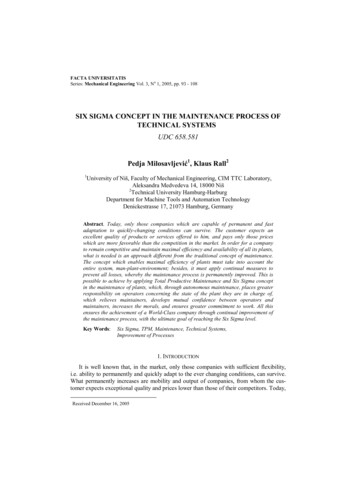
Transcription
FACTA UNIVERSITATISSeries: Mechanical Engineering Vol. 3, No 1, 2005, pp. 93 - 108SIX SIGMA CONCEPT IN THE MAINTENANCE PROCESS OFTECHNICAL SYSTEMSUDC 658.581Pedja Milosavljević1, Klaus Rall21University of Niš, Faculty of Mechanical Engineering, CIM TTC Laboratory,Aleksandra Medvedeva 14, 18000 Niš2Technical University Hamburg-HarburgDepartment for Machine Tools and Automation TechnologyDenickestrasse 17, 21073 Hamburg, GermanyAbstract. Today, only those companies which are capable of permanent and fastadaptation to quickly-changing conditions can survive. The customer expects anexcellent quality of products or services offered to him, and pays only those priceswhich are more favorable than the competition in the market. In order for a companyto remain competitive and maintain maximal efficiency and availability of all its plants,what is needed is an approach different from the traditional concept of maintenance.The concept which enables maximal efficiency of plants must take into account theentire system, man-plant-environment; besides, it must apply continual measures toprevent all losses, whereby the maintenance process is permanently improved. This ispossible to achieve by applying Total Productive Maintenance and Six Sigma conceptin the maintenance of plants, which, through autonomous maintenance, places greaterresponsibility on operators concerning the state of the plant they are in charge of,which relieves maintainers, develops mutual confidence between operators andmaintainers, increases the morals, and ensures greater commitment to work. All thisensures the achievement of a World-Class company through continual improvement ofthe maintenance process, with the ultimate goal of reaching the Six Sigma level.Key Words:Six Sigma, TPM, Maintenance, Technical Systems,Improvement of Processes1. INTRODUCTIONIt is well known that, in the market, only those companies with sufficient flexibility,i.e. ability to permanently and quickly adapt to the ever changing conditions, can survive.What permanently increases are mobility and output of companies, from whom the customer expects exceptional quality and prices lower than those of their competitors. Today,Received December 16, 2005
94P. MILOSAVLJEVIĆ, K. RALLa high degree of automation is typical of a majority of companies, whereby technical systems and the way in which they are used affect expenses, process quality, and productquality. In order for a company to remain competitive, what it needs are several conceptsso that it may achieve and maintain maximal efficiency of its technical systems.One of the concepts which cannot be avoided in reaching World-Class maintenance ina company is the application of Total Productive Maintenance - TPM. Those companieswhich have neither strength nor will to apply this approach of maintenance must definetheir mission, vision, goals, planned results, and operative strategies for realizing substantial improvement. On the contrary, it is only a matter of time when such companieswill disappear from the market.The process of maintenance becomes of increasing importance for companies, as it directly affects other relevant processes leading to customers' satisfaction or dissatisfaction.It is no longer possible for companies to uncontrollably spend their resources in themaintenance process (time, material means, money, etc.). Companies in Japan were thefirst to introduce this principle, and they went on to improve the maintenance process oftechnical systems, which led to their increased competitiveness in the global market. Special improvement in this field was made when it was realized that the maintenance oftechnical systems was, in fact, "a medical science on equipment", and when experiencefrom other fields of improving maintenance processes was applied.2. MODEL OF WORLD-CLASS MAINTENANCE PROCESS (WCMP)The competition existing in today's market forces companies to eliminate all unrequired steps from their processes, i.e. all "trash" from processes. Only those companiesdoing the right thing (effectively) in the right way (efficiently), thus managing to eliminatethe losses which occur in processes, can survive in the market. In this manner, they comecloser to Best-in-Class processes, with a permanent tendency towards World-Class processes. World-Class processes represent the best among the best processes. Thus, for example, Six Sigma processes represent World-Class processes, as they allow only 3,4 errors per million chances for error.When it comes to maintenance, a World-Class process means the best model of themaintenance process, which presupposes that it is comprehensible for all participants inthe process, that it is easy to apply and requires minimal implementation costs as well asthat it is universally applicable and increases overall efficiency of technical systems,which ultimately leads to a greater profit for the company.The modern approach means application of known scientific methods in the field ofmaintenance, but also of knowledge of experienced operators and maintainers of technicalsystems. To reach a World-Class maintenance process, it is necessary to incorporate theexperiences of TPM into process management, which results in a model which may beimplemented in a majority of companies in different branches of industry.To reach the Six Sigma level in the maintenance process, it is necessary to model aWorld-Class maintenance process, based on the concept of total productive maintenance,which would result in increased productivity, improvement of quality, reduction of expenses, and creation of better working conditions. Such effects are achieved through permanent improvement of maintenance activities, coupled with increased morals of employ-
Six Sigma Concept in the Maintenance Process of Technical Systems95ees and their motivation for work, which includes a radical change of culture of companies [4].On the basis of some advantages which have been noticed, but also of shortcomings ofthe existing models and concepts of maintenance, and through overall analysis of theTPM concept, which was modified and adapted to process approach to maintenance, thenew maintenance concept was modeled, based on applying the modern scientific-technological achievements.The proposed model of World-Class Maintenance Process (WCMP) is created as asymbiosis of the existing maintenance concepts; it includes application of tools of qualityand management, as well as of tools of Six Sigma concept. The model WCMP consists ofalgorithms of procedures in eight steps, which lead to the World-Class maintenance process through continual improvement (Fig. 1) [1]:1. Making decision on introducing the World-Class Maintenance Process (WCMP);2. Training of participants in implementing the WCMP in the company;3. Recording the existing maintenance process;4. Determining important processes in maintenance;5. Defining the scope and phases in implementing the WCMP;6. Application of the TPM concept in the company;7. Standardization of maintenance procedures; and8. Improvement of the maintenance process.Fig. 1. Model of World-Class Maintenance Process (WCMP)
96P. MILOSAVLJEVIĆ, K. RALL3. TOTAL PRODUCTIVE MAINTENANCE AND SIX SIGMAA total-productive maintenance is a term describing the new philosophy and new approaches to design and management of the maintenance process. The point of this philosophy is how to radically reduce dissipation of resources and substantially increase theuse made of plants and equipment, so that responsibility for proper operation and functioning of technical systems is shifted on the employees, which directly operate them.This led to the creation of autonomous maintenance, which broke down the barrier between specialists in maintenance services and direct operators, in control of equipmentand machines.Excellence is better than the best, which means that there is always something whichcan be better than the existing, i.e. that it is possible to achieve the vision of zero errorsand zero interruptions, zero dissipation, etc. To achieve something better than the existingmeans to explore the possibilities of improving the existing models and concepts ofmaintenance, and to, on this basis, propose an improved model of the maintenance process, which will meet all requirements of the TPM philosophy, but also the requirements ofSix Sigma concept.Introducing the integrated TPM model and Six Sigma concept leads to an improvedmodel of the maintenance process, which uses all advantages of the TPM approach, butalso, through simultaneous application of Six Sigma concept, enables reduction of variations in the process, eliminates the occurrence of errors, and reduces the time cycle of themaintenance process.Integration of Six Sigma concept in the TPM maintenance model was performed byusing the DMAIC-model of improvement of performances, which improved the existingTMP approach to maintenance, and made it simpler and clearer for the users who wish toapply these new concepts in maintenance. The new model of World-Class maintenanceprocess is illustrated by a clear graphic interpretation, which gives a clear picture of thenew approach, and which is comprehensible for those experts already experienced in applying the TPM Six Sigma concept, but also for those who are yet to move in this direction.4. REACHING SIX SIGMA MAINTENANCE PROCESSImprovement of the maintenance process should not be the ultimate goal, but reachingSix Sigma maintenance process. Continual improvement of processes is based on theopinion that, however good something may be, it can always be better.To improve the maintenance process Six Sigma concept may be used as a simplemodel of improving performances, based on PDCA-cycle, under the name DMAIC (Define-Measure-Analyze-Improve-Control). This model of improvement and design/redesignof processes enables reaching Six Sigma process performances, with planned result of 3,4errors per million chances for error (Table 1).Six Sigma is a system which combines tools for continual improvement, by focusingon processes, their analysis, and comparison. What is common to all various processes ina company is the defect, which causes extra work, reject, and increased costs. Six Sigmasystem measures defect in the process and normalizes them, so that it is possible to com-
Six Sigma Concept in the Maintenance Process of Technical Systems97pare the processes, which, in its turn, enables making a decision on arrangement of resources for better performances. As the ultimate goal of Six Sigma concept is work in theprocess with no errors, it is also necessary to trace the errors which occur in the process.The model of World-Class maintenance process, as a specific "ticket" to Six Sigmamaintenance processes, is related to the DMAIC-model for improving the performances ofthe maintenance process, advanced Six Sigma tools and quality tools, as shown in Fig. 2 [1].Table 1 DMAIC-model of Improving the Maintenance ProcessSix Sigma improvement processesDescription of activity1. Define goals of improvementactivity.Improvement of processes Determine requirements; Set the planned result.Design/redesign of processes Identify problems; Define the planned result;2. Measure the existing system Confirm problem/process;by setting reliable metrics for Filter problem/plannedsupervision of progressresult;towards goal and use analysis Measure key steps.of information. Measure performancesaccording torequirements; Gather information onprocess efficiency.3. Analyze the system to Develop hypotheses oneliminate gaps between currentcauses;system or process Identify "vital minority" ofperformances and the desiredthe root of causes;goal. Apply statistic tools to Confirm hypotheses.perform analysis. Identify "the best practice"; Assess process design; Filter the requirements.4. Improve the system, by using Develop ideas for removingproject management and otherthe root of causes;tools of management and Test solutions;planning, as well as statistic Standardize solutions andmethods, to validatemeasure results.improvements. Design new process(check assumptions, applycreativity); Implement new process,structures, systems.5. Control the new system.Institutionalize the improvedsystem by modifying thesystem of rewards, policies,procedures, budget, etc. Set and reexaminemeasurements to maintainperformances; Correct problems asrequired. Set standard measurementsfor maintenance ofperformances; Correct problems asrequired.
98P. MILOSAVLJEVIĆ, K. RALL
Six Sigma Concept in the Maintenance Process of Technical Systems994.1 I phase of DMAIC-model: DefineIn this phase of improving the performances of the maintenance process, which, in themodel of World-Class maintenance (WCMP) relates to the first two steps (making decision on introducing WCMP and training users for implementation of WCMP), it is necessary to identify the problems which occur in processes, determine requirements, and define the planned result of improving the maintenance process.The most responsible individuals for this phase are top-managers in the company, asthey are the ones who can have the most complete view of all processes, how they arecarried on, engaged resources, process documentation, relations with other processes, etc.About these procedures, they should consult maintenance experts, who have the knowledge and skills in the field of maintenance of technical systems, and are best acquaintedwith concrete maintenance processes of certain parts or the entire technical system.This comprehensive analysis represents a sort of a filter, which determines the willingness and readiness of the company to implement the new maintenance concept.Workers-direct executives in manufacture, and workers in maintenance, with theirpractical experience, may contribute to identifying problems, as they are directly facedwith concrete problems in their field of work in their daily activities. They know in detailthe technical systems they operate and maintain, and can recognize and solve the problems which are sometimes specific to a certain technical system, and need not coincidewith technical-technological measures for correct functioning and maintenance of technical systems when they are in the state of "operation".This phase of the concept usually includes participation of the already formed TPMtraining teams, who enable participants in the process of implementing the WCMP forperforming the activities from the TPM concept, and improve their work and decisionmaking in team work. Trained operators and maintainers of technical systems form multidisciplinary teams, which have the required knowledge and skills for performing theprocedures of autonomous maintenance, and make coordinated decisions. These teamsalso actively participate in identifying problems and defining requirements, as they consistof participants in the process of implementing the new maintenance concept.Defining the planned results of improving the maintenance process relates to achieving a maintenance process without errors and interruptions, and without accidents or injuries at work. As a consequence of these results of improvement, both direct and indirectcosts of maintenance are reduced, reliability of technical system increases, product qualityreaches a higher level, the lifetime of a technical system is prolonged, customers are moresatisfied, and the company makes more profit in the market.It can be freely said that the phase of defining is the most important phase in the process of improving the maintenance system performances and its path towards Six Sigmaprocesses, as is the case in which consciousness is created and the need to change the existing concept of maintenance is confirmed, in order for the culture of a company to ultimately be changed. This change is achieved through education, as people should learnnew skills, at the same time overcoming old modes of thinking.Changing the culture of a company means a change in practice and protocols whichpeople follow, as well as in values, which affect the way people react and their behaviorwhen proposing changes of any type.
100P. MILOSAVLJEVIĆ, K. RALLThis phase must also include the application of planning of quality directed towardsrequirements of users (Quality Function Deployment-QFD), as one of the advanced toolsof the Six Sigma concept.4.2 II phase of DMAIC-model: MeasureThis phase is applied when recording the existing maintenance process and determining the processes relevant for maintenance. Detailed knowledge of the existing maintenance process includes description of the maintenance process, drawing process chards,and completing the SIPOC-table. In doing this, possible existence of problems in theprocess is confirmed, the process is filtered and simplified, unnecessary and inefficientsteps in the process are eliminated, and narrow points, which cause misuse of capacitiesof technical systems and transform serial activities into parallel, are eliminated, whichreduces the time of waiting in the process.Measurement in the process includes not only gathering information from the process,but also analysis of the existing information about the technical system, starting from itsdelivery, implementation, and putting into operation, to the moment of establishing a reliable way of measuring parameters and performances of the process. In charge of theseactivities should be teams for autonomous maintenance and improvement of maintenanceprocesses, as they consist of people who are readily identify problems which occur in theprocess. At the same time, these teams gather and analyze information about efficiency ofthe process, reliability of certain parts or the entire technical systems, time required forthe maintenance process, costs of maintenance, etc.This phase of the DMAIC-model includes application of the following quality toolsand advanced tools of Six Sigma concept: Statistical Process Control-SPC; Failure Mode and Effects Analysis-FMEA; Measuring Customer Satisfaction-MCS, etc.4.3 III phase of DMAIC-model: AnalyzeThe purpose of analyzing the process of maintenance is to determine what is not goodin the process, what the causes of its inefficiency are, as well as to propose how it can beimproved. As is the case with the previous two phases, this phase for improving themaintenance process performances is also related the fifth and sixth steps of the model ofWorld-Class maintenance process (defining the scope and phases in implementing theWCMP and application of the TPM concept in a company).As in step three of the WCMP model (recording the existing maintenance process) theexisting resources were already defined and the type of technological process was alreadyrecognized, the system is analyzed before making the decision on the scope and time interval needed for introducing the new maintenance concept. Assumptions on possiblecauses of problems are made, and "vital minorities" of the root of causes are identified,and these assumptions are confirmed or denied.When applying the TPM concept in a company, experiences of other companies inimplementing the TPM concept are used, it is assessed whether applied measures are satisfactory, leading towards planned results of improvement of process, and whether established requirements for improving the maintenance process are actually applicable, or
Six Sigma Concept in the Maintenance Process of Technical Systems101they need to be redefined and filtered. These activities are in charge of leaders of TPMteams, as well as possible coordinators for implementing TPM, as they have the bestknowledge of measures for carrying out the TPM concept.Analysis also includes possible errors, which occur in the process the most frequently,and the causes of these errors. Application of adequate quality tools enables eliminatingthem in the following phases of the DMAIC-model.This phase, as was the case with the previous one, requires application of quality toolsand advanced tools of Six Sigma concept, such as: Pareto-analysis; Cause-effect diagram (Ishikawa-diagram); Design of Experiment-DoE).4.4 IV phase of DMAIC-model: ImproveAs from problem-solving teams in the sixth step of the WCMP (application of theTPM concept in a company) teams for improvement are made, composed of memberstrained for using problem-solving techniques, they propose corrective measures for improving the maintenance process. This phase of improving the maintenance process performances also includes standardization of procedures of maintenance, i.e. making procedures and instruction manuals, which define the duties of workers-operators, provide description of workplace and applied means of work, describe the procedure of work atworkplace, set measures for protection of workers and the environment, etc.Process improvement includes making a proposal for improving the process, defininga strategy of improvement, recording "to-be" process (whatever they should be), elimination of activities which do not create extra values, elimination of possible causes of variations in the process, assessment of risk, and testing.Improvement of the maintenance process sometimes means redesign or re-engineeringof the process, i.e. design and implementation of a completely new process, its testing,and standardizing the solution. In this case, the creativity of all employees is required.Process redesign represents the changes made inside the process, such as: adding newactivities, introducing new documents, different procedures, etc. Process re-engineeringrepresents radical changes which surpass the scope of a process.Process improvement includes the following activities: Making an action plan; Measuring and tracking the efficiency of the improved process; Tracking the newly created values; Optimizing relations in the superordinate process; Process management; and, Continual improvement of process.Through continual improvement, the maintenance process gradually reaches SixSigma level.4.5 V phase of DMAIC-model: ControlThe control phase is very important, as it enables confirmation of introduced improvements. Control relates to all steps of the WCMP model, with establishing standard
102P. MILOSAVLJEVIĆ, K. RALLmeasurements of maintenance process performances, and problems are corrected whererequired. This phase involves participation of all employees of the company, starting fromtop-managers, through teams for TPM-education and improvement, to workers-operatorsand maintainers, as they are in charge of activities from the TPM-concept.Process of control includes the following activities: Making control chards; Management of processes of change; Documentation and standardization of the improved maintenance process; Supervision of the maintenance process through control chards; Checking stability and ability of the maintenance process; Proposing measures for further improvement of the maintenance process.Control of the entire maintenance process is based on measuring process performances, which are continually tracked over time, with the goal to observe trends, the bestand the worst practices, and possible fields for improvement. Each process has the possibility to get out of control and cause problems. For this reason, all participants in theprocess of implementation must be controlled effectively, while control must become partof everyday activities of all employees of the company.However, relying solely on control to improve process (finding problems, errors, etc.)includes a high probability for the occurrence of an error or breakdown in the technicalsystem. What is required instead is a continual effort to reduce or eradicate errors andbreakdowns depending on the human factor. Control as the only means of process improvement can frequently come too late. A long-term process quality comes not only fromcontrol, but also from improving the process and the entire technical system. Practically,there are technical and financial constraints to process improvement, but the final goal isthe Six Sigma maintenance process or performing the process completely without errors.5. APPLICATION OF MAINTENANCE MODEL BASED ON THE TPM CONCEPTPublic (communal) companies have a very important role in the economy of eachcountry, as their functioning affects vital needs of the population, such as provision ofelectrical energy, water, thermal energy, etc. Their technical systems have strictly definedtasks, which must be realized in keeping with certain criteria. Therefore, timely, effective,and efficient execution of the maintenance process is crucial for doing business successfully in public companies. Users of their services have very high requirements with respect of satisfying their needs, so that high availability, reliability, and optimal state oftechnical systems can be reached only through interaction of the people who directly operate them, and the technical systems themselves.Absence of an adequate concept and quality approach to maintenance of technicalsystems in public communal companies may lead to: Low level of communal services; Increased costs of business; Low reliability of technical systems; Reduced exploitation properties of equipment; Inability to complete workplans; Reduction of planned income;
Six Sigma Concept in the Maintenance Process of Technical Systems103 Dissatisfaction of users of services; and, Creation of a bad working environment, etc.Large communal systems with sizeable objects, equipment, and installations belong tolarge technical systems, whose maintenance must be covered carefully, in order to realizefull efficiency of technical systems. Unpredictable, sudden breakdowns in parts of thesystem may cause breakdown of the entire system, which not only increases the costs ofmaintenance, but may also cause substantial damage in other respects. For this reason, thetechnical part of such systems must have a certain percent of backup capacities, used toalleviate or completely eliminate these unpredicted situations. The age of objects, equipment, and installations is also a very important factor to be reckoned with.For all these reasons, management must treat the maintenance function as one of thestrategic functions in the company, whereby the following facts must be born in mind:1. Technical systems in public (communal) companies must reliably perform their tasks;2. Their work must be efficient and rational;3. Expenses must be within planned limits;4. The use of maintenance resources must be optimal;5. Maintenance tasks must be supported by modern scientific achievements (benchmarking, reengineering, TPM).Therefore, if we want an efficient and rational functioning of public (communal) companies, maintenance of their technical systems must be systematic and planned. This systematic approach to maintenance includes a certain sequence of activities, which mayenable quality maintenance in keeping with requirements of the technical systems. Thisapproach includes:1. Determining the concept of the maintenance program;2. Planned development of the maintenance concept;3. Sequence of activities of maintenance procedures;4. Time normatives for maintenance activities;5. Analysis of maintenance procedures-logistic support;6. Analysis of the costs of maintenance;7. Introducing an information system into maintenance;8. Control of supplies, spare parts, and materials;9. Planning modernization or reconstruction; and10. Control of maintenance personnel [8].5.1 Application of the model in PCC "City Heating Plant"-NišThe described maintenance concept based on applying measures 5S-CANDO andautonomous maintenance, was applied in boiler house "Krivi vir" of PCC "City HeatingPlant"-Niš. A six-member team of plant operators was formed. The steps of autonomousmaintenance were applied, and they yielded expected results, primarily in the field of arranging the place of work, speed and efficiency of performing the activities of yearlyoverhaul, and increased motivation for work and morals.The process of yearly overhaul includes: boilers, blowpipes, ventilator rooms, pumpand masut stations, and external reservoirs [9].Fig. 3 represents the chard of the process of yearly overhaul of thermal sources in theboiler room.
104P. MILOSAVLJEVIĆ, K. RALLP5.1P5.2BoileroverhaulStartD7D9C4Results ofAuthorizedmeasuringservicepipe thickness C3.1Record ofperformedtasksManagerof thermalsourcesWorkorderD8Contract onperformanceof tasksD2C3.2Chief ofboilerhouseWorkorderP5.3Ventilator roomoverhaulBlowpipeoverhaulC3.32 executivesD2C3.3WorkorderD22 executivesC2.3D2Workorder2 locksmithsServiceinterventionsC3.32 executivesC2.32 locksmithsC1.22 automationtechniciansP5.4P5.5Pump stationoverhaulD2WorkorderC3.32 executivesC2.32 locksmithsP5.6Mazut stationoverhaulD2D2WorkorderWorkorderC3.32 executivesExternal stationoverhaulD2EndC3.3Workorder2 executivesC2.32 locksmithsFig. 3. Chard of the process of yearly overhaul of thermal sourcesFig. 4 represents the chard of the process of yearly overhaul of boilers, which consistsof the following maintenance activities:1. Visual checking of the boiler;2. Determining the state of the boiler;3. Mechanical cleaning, chemical washing, neutralization and conservation of the boiler;4. Announcement of a public tender for performance of tasks;5. Performance/control of tasks;6. Chamotting of boilers (according to tender);7. Conservation of smoke and water sides of boilers;8. Chamotting of boilers;9. Checking, cleaning, and lubrication of flue flaps;10. Checking and changing all manometers and thermometers;11. Checking safety valves;12. Checking and pre-packing muck valves;13. Checking the state and overhaul of electromotor and mechanical valves;14. Checking all openings on boilers and changing asbestos; and15. Checking, pre-packing and cleaning openings for observation of fire [1].
Six Sigma Concept in the Maintenance Process of Technical SystemsP5.1.1P5.1.3Mechanical cleaning,chemical w ashing,neutrali
Six Sigma Concept in the Maintenance Process of Technical Systems 97 pare the processes, which, in its turn, enables making a decision on arrangement of re-sources for better performances. As the ultimate goal of Six Sigma concept is work in the process with no errors, it is also


